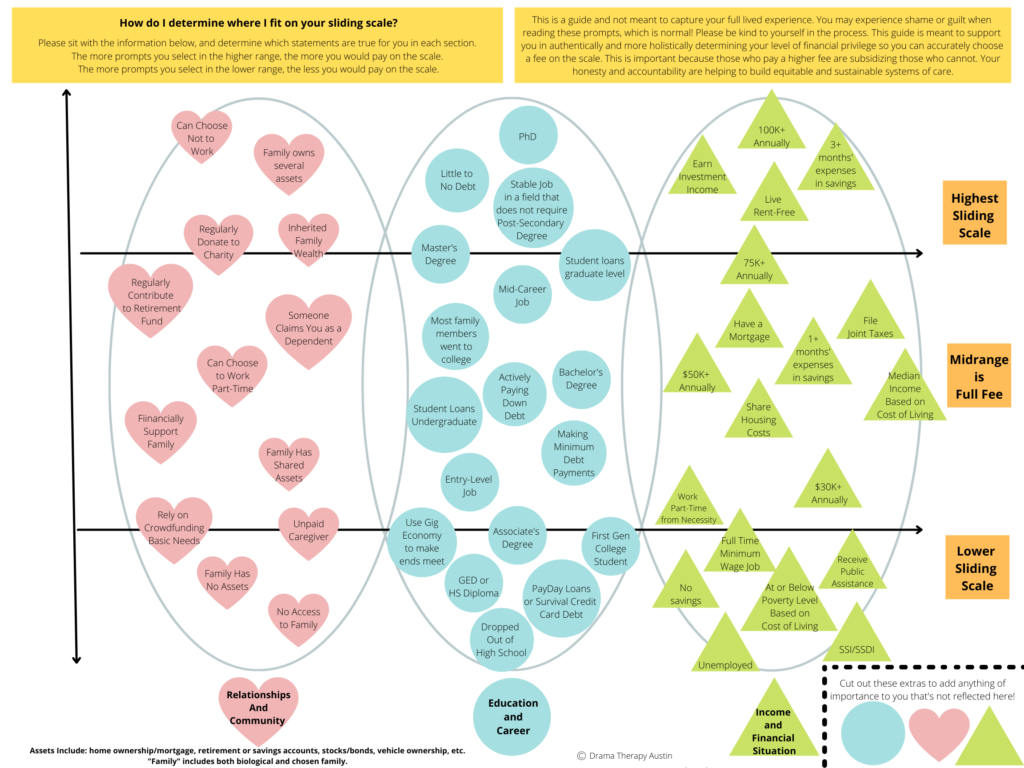I mention throughout this website that I offer sliding scale fees for my services.
But what does that even mean? Why have I chosen to do it? And how do I determine the scale?
This article is an attempt to unpack and demystify sliding scale.
What is sliding scale?
Sliding scale simply means there is a set range of payment options a given provider is willing to accept for a given service.
Clients may “slide” up and down that scale based on their income (or other relevant factors chosen by the provider).
Why offer sliding scale?
Sliding scale usually comes into play when someone is offering a service.
Goods tend to have a more fixed price point, though merchants will put items on sale or clearance.
When someone is selling a service, however, it is trickier!
Service providers sell their time and expertise. This can be challenging to quantify.
Generally, sliding scale is offered with the goal of affordability.
To make their services accessible regardless of class, providers create a range of acceptable payment levels. This allows them to serve lower-income clients without causing financial hardship on either side.
How do I know what part of the scale I should “slide” to?
I used to offer sliding scale on the “honors system.”
I told potential clients my sliding scale range, and asked them to determine what they thought they could afford. And that is what I would charge them.
I have come to realize, however, that this is not necessarily an easy ask!
And, we are not always able to provide the most accurate or objective assessment of our own financial situation.
What counts as a lot of money varies widely, based on a lot of different factors.
Sliding Scale and Social Justice
I offer sliding scale as a part of my commitment to social justice.
Which includes recognizing that it can be challenging for folks to unpack where they hold power and privilege.
In the U.S., talking about money is also often considered taboo. So, people may not have experience or skills when it comes to talking about money.
This can make it even more challenging for someone to accurately place themselves within a sliding scale range.
Sliding Scale Guide
As a result of all these factors, I have created the following guide to help individuals discern where to situate themselves on my sliding scale.
The guide includes lived experiences related to three categories: Relationships and Community, Education and Career, and Income and Financial Situation.
By looking more holistically at your financial situation, I hope it will become easier to determine what fee within the sliding scale makes the most sense for you.
Keep in mind that those with more power and privilege are helping to subsidize the care of those who are more marginalized and oppressed.
Individuals who pay on the low end of the sliding scale are not paying the full cost of the services they receive. Giving more when you have access to it allows for services to be distributed more equitably.

You can also download a PDF of the image below. This will allow you to enlarge the text, or take notes on it.
How I Position Myself
Offering services on a sliding scale also allows me to take my own axes of privilege and marginalization into account when setting my rates for services.
I am queer, trans non-binary, and disabled. I also do a significant amount of volunteer work directly in the communities I serve. These factors affect the rates I need to be able to charge for services, so that I can be financially stable.
Individuals who work with me are benefitting from both my lived experience, and decades of active involvement in marginalized communities. This includes experiences of trauma, housing instability, poverty, and other adverse experiences.
Furthermore, it takes a lot of time and energy to run a business. The time I spend in a workshop or session is only a fraction of my working hours. Each workshop or session reflects AT LEAST three to four times the working hours reflected by the face-to-face time we might spend together.
My fees reflect the true cost of the services I offer, including time spent on marketing, accounting, continuing education, administrative tasks, research and planning, and writing articles like this! Not to mention certification renewal fees, website hosting, calendar and scheduling apps, televideo platforms, and other business expenses.
This is why sliding scale is so important. When those who have more pay more, it increases access for everyone!
Next Steps
If you have any questions, or need assistance with the guide, you can contact me. We will arrange a meeting where we walk through it together.
A special thank you to Ride Free Fearless Money for their article and PDF related to sliding scale, from which I drew the inspiration for this post!